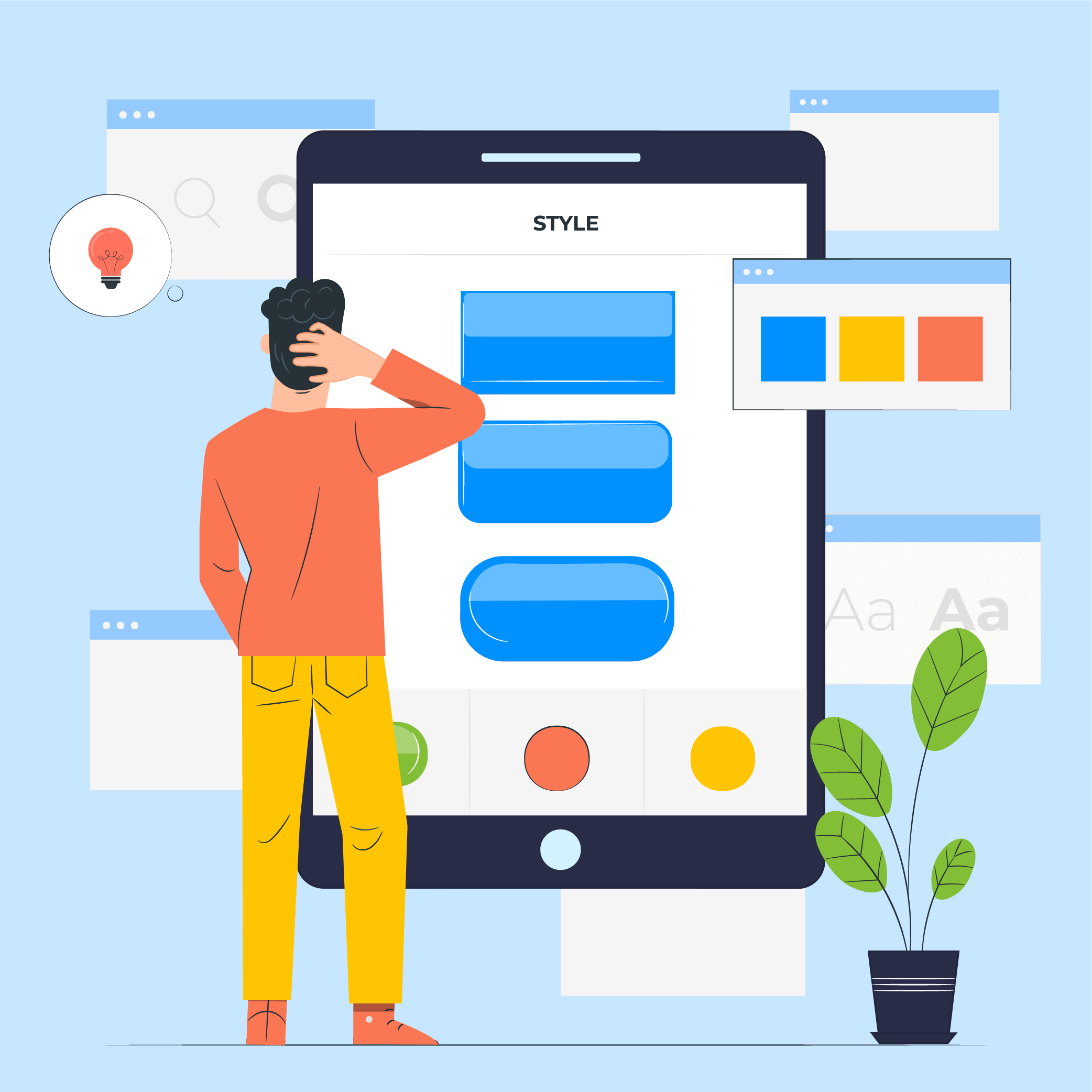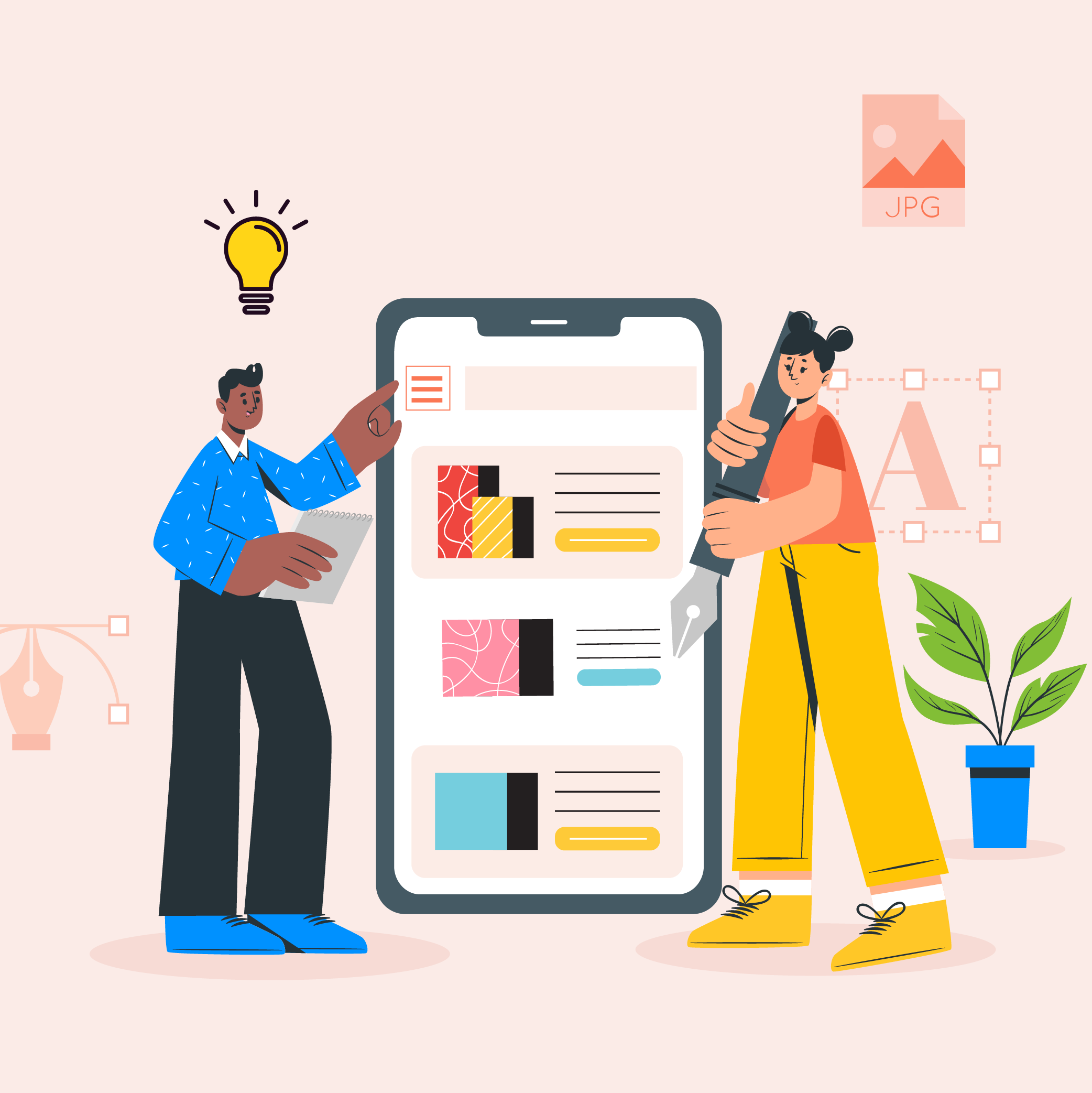- What are the Benefits of Mobile App Prototyping?
- 1. Clarity
- 2. Validation
- 3. Funding for prototype
- 4. Freedom
- What are the Types of Mobile Application Prototypes?
- Low-fidelity prototypes
- High-fidelity prototypes
- What is the Mobile App Prototyping Process?
- 1. Identify the problem
- 2. Concept mapping
- 3. Feature ideas
- 4. Storyboard
- How to Get Angel Funding for your Mobile/ Web App?
- Angel investor networks
- Look at other apps in your category which have received funding recently
- Create a presence on websites that investors frequently visit
- Tips to Convince Angel Investors
- How Appinventiv can help you with Mobile App Prototyping
- Conclusion
- FAQs
The core of every digital product’s existence is its actionable idea that solves the prospective user’s pain points. It’s necessary to materialize your vision and subject it to testing to gain validation of your design and raise funding for apps if required. This process is also known as creating a prototype for your mobile application. Prototyping, in the modern-day mobile app design and development world, has become a crucial element in the whole process.
[Also Read: The complete guide to mobile app design]
This integral place that mobile app prototyping holds, straight from the stage when the foundation of the mobile app development is laid, is what has made it a source of generating funds from investors. If you want to know how to get investors for an app, give this blog a quick read.
When you start building an app, most people get swayed and add multiple new functionalities, overloading it with features that users might not use. Prototyping helps you identify what users are missing in the app and help you design that entices people to use the application.
Now, before we move to the stage where we discuss the steps of getting angel funding for prototype, let us first look at the various benefits of mobile app prototyping.
What are the Benefits of Mobile App Prototyping?
App prototyping tools help create designs that allow users to engage in the app and deliver an experience similar to when the actual app is deployed. It lets them take a test drive of the app design before the development cycle begins. Let’s understand some other benefits of mobile app prototyping.

1. Clarity
The biggest benefit attached to the development of prototypes is the clarity it offers regarding the app’s functionality and the user flow inside the mobile app. Gathering an understanding of how the app would function is very difficult without a visual representation.
By developing the interface, interaction, and images in a prototype, the stakeholders get to see and interact with the app, which then helps them to gauge if the app should be further developed or not.
2. Validation
Prototyping is the first step of getting validation from the end users and stakeholders regarding the app idea and conceptualization.
When rolled out to a pool of prospective users, the method is crucial for gaining insights into how the app would be accepted later in the market. A prototype can get the marketers a series of information about the ease of usage, app’s functionality, and understanding of how the users are interacting with the app.
3. Funding for prototype
An app prototype gives investors the validation of the product’s profitability and its potential to reach the market. By demonstrating the exact app’s flow and the functionalities present in the mobile app, prototypes become a looking glass for the investors to ensure that the app would work and is prepared to attract a huge user base.
Mobile app prototypes play a huge role in getting your product massive funds irrespective of which traditional or non-traditional funding models you plan to implement.
4. Freedom
Prototyping is more or less the only part of the mobile app development process that gives you the freedom to make changes and do A/B testing.
The end result of an app prototype can go two ways – A. the idea might be absolutely perfect (a rare event), B. There might be changes that would get highlighted after studying the user experience on the prototype (a common occurrence).
If your business falls in category B, prototyping is the only stage that will give you the time and space to work on an alternative to change the route of your mobile app development process.
Now that you are familiar with the benefits of mobile app prototyping let’s know the two types of prototyping that help get funding for app development.
What are the Types of Mobile Application Prototypes?
Depending on the requirement of a business, prototypes can also be divided into two parts –
- High fidelity
- Low fidelity
When we talk about Prototype Fidelity, we ar are mainly talking ing about how the look and feel of the product are portrayed to the stakeholder. Suppose there are several intricate details. In that case, the prototype will be put into the high-fidelity mobile app prototype demarcation. Likewise, if the product is only a basic, ready-to-test portrayal of the app, it is called a low-fidelity mobile app prototype.
Let us look into both low and high-fidelity prototypes in some more detail –
Low-fidelity prototypes
Lo-Fi prototypes are a fast and easy method to translate high-level design modules into testable and tangible artifacts. The main objective of a low fidelity prototype is to check the app first and then test the app’s functionality and visual appearance.

Here are the basic attributes of a Lo-Fi Prototype –
- Visual – Only selected attributes of the app are presented.
- Content – Only the main content is added in the prototype
- Popular Techniques of Low Fidelity Prototypes – Paper prototype and clickable wireframes.
High-fidelity prototypes
Hi-Fi prototypes look and offer functionality similar to the product to be deployed. Prototype app design service providers usually develop high-fidelity prototypes. Initially, they focus on clearly understanding what they will develop and when to test the app and share it with investors to generate funds.

Here are the attributes of the high-fidelity prototype –
- Visual – Detailed and realistic designs that replicate the original mobile app design.
- Content – The designer uses real content, usually appearing in the finalized prototype app design.
- Interactions – The interactions happening on the prototypes are very realistic.
- Popular techniques of high fidelity prototypes – Digital prototypes, coded prototypes.
With this, you now know not only the different associated benefits of prototyping but also the options available to you when prototyping a mobile app.
Now, the next and most crucial part that stands between you and your app idea funding is how to make a prototype.
In the next section, we will be looking into the right way to build a prototype, which would give a product that can be shared with the investors to initiate funding for app development.
What is the Mobile App Prototyping Process?
How to make a prototype is one of the most frequently asked questions, so this section will give you step-by-step insights into the mobile app prototyping process. The mobile app prototyping process involves 4 major stages:

1. Identify the problem
The first stage in mobile app prototyping starts with identifying the problem that the users are facing in the market. Your app should be specifically about the pain points which can be solved with a mobile app. This stage involves preliminary research methods such as interviews and extensive surveys.
Mostly the problems that businesses think are prevalent differ from the root cause. It can be easily analyzed in detail by conducting a real-time one-to-one interaction with the user
2. Concept mapping
The next stage of how to make a product prototype process is concept mapping. In this stage, we help map out the various data collected through mapping.
The development of a concept map starts with first identifying the main issue faced by the users. Once you have identified the main issue, also known as the ‘focus question,’ start listing down all the related data you have.
Next, with your main concept on top, start organizing all the related data/information hierarchically, i.e., according to broad to specific.
The idea of a concept map is to help create a user flow that would define what a user would seek to achieve through the app movement. This user flow then goes on to help create of mobile app features.
3. Feature ideas
Once you are done with creating the concept map and user flow, make a list of features that you believe users would need to perform specific functions within the mobile app.
Divide this process into two stages – A. Noting down all the features and B. Refining the list of features.
Stage A is pretty self-explanatory – list down all the features that come into your head without thinking of its viability. Stage B is where you refine the features list. To do it perfectly, measure the features against the below checklist
- Is the feature useful?
- Is the feature desirable?
- Will it be easy to use?
- Will the feature be functional? ble
- Is it sustainable?
Now that we have finalized the features, the next and close to the end stage is “Storyboarding.”
4. Storyboard
A storyboard helps create a layout of how the user would fit in and work around the app in his day-to-day life.
Storyboarding helps you identify the following things –
- Pain point of the user
- Processes that will be replaced by the app
- Processes that won’t be replaced with the app
- The must-have app features
- Features that should be removed
Once your storyboard is ready, the next and last stage left for you to cover is to create a prototype and test it among a pool of real prospects.
Now that we have looked into the perks of investment in prototype development and the different options businesses have when it comes to prototype mobile app development. Let us move on to our article’s most important segment – how to get prototype funding for an app idea.
How to Get Angel Funding for your Mobile/ Web App?
The first and foremost step for getting funds for your mobile app prototype is the creation of a “Proof of Concept.” The idea is to get your prototype mobile app validated from the pool of real users and collect their positive responses and experiences. You can share these experiences and real-time acquired data with angel investors.
The next stage after collecting proof of concept (PoC) is to find angel investors. Now, the answer to ‘how to find an angel investor for your mobile app’ can be challenging. Most angel investors prefer to remain anonymous and prefer to stay behind the curtains.
[Also Read: The strategy closest to product market fit- PoC vs MVP vs Prototype]
Nevertheless, there are three major ways to find angel investors for your mobile app.
Angel investor networks
Generally, what happens is that the Angels keep aside money for angel investments, which are screened by the team of managers. This way, the investors get to keep their anonymity. There are different angel investor networks available across nations. You can conduct online research and list the top investors to reach out to them. You can book a meeting with them or email them to get funding for an app.
Look at other apps in your category which have received funding recently
If you are hoping to find and impress an investor in some meetup or fundraising, good luck. It’ll hardly ever happen. So, instead of wasting your time signing up to each and every meetup with the sole aim of finding an angel investor, study the app funding companies that gave funding to your competitors. It will help you identify the major players interested in your domain, and you can contact them as well as their competitors for app funding.
Create a presence on websites that investors frequently visit
Open an account and create a strong business presence on websites like IndieGoGo, Kickstarter, RocketHub, Fundable, etc. It is no hard and fast rule to restrict yourself to only the websites mentioned above. However, these platforms are frequently visited by several investors. Generally, it has been seen that those entrepreneurs get greater visibility whose profile is filled with numbers and media. So, make sure to create your app’s demonstration video.
Once you have found a list of top angel investors who might be interested in your venture, it is time to send them an email pitch. Ensure that you highlight the “Proof of Concept” in the email.
With this, you are now ready to venture into the world for getting app development funding solely based on your app prototype. Make sure that the created prototype of the mobile app belongs to a high fidelity category and is ready to attract funds from investors.

Tips to Convince Angel Investors
Here are a few tips that will help you deliver a great impact on angel investors while convincing them:
- Prepare a good presentation
- Highlight unique features of your app
- Keep updated statistics in the presentation
- Even more transparent
- Mention all functionalities in short
- Showcase your app prototype example
- Do not use technical language as an investor might not understand
- Keep business presentation professional
- Be polite while explaining
How Appinventiv can help you with Mobile App Prototyping
Appinventiv, a leading mobile app design services provider, has an amazing backtrack of collaborating with clients worldwide for their app prototyping and development requirements. Our team of experts has extensive experience and knowledge in diverse prototyping tools that help you build an accurate prototype that helps you raise funds from angel investors.
For instance, we helped VYRB, a voice-assistant app that delivers a unique social media experience, with its app prototyping. With the accurate prototype we built for them, the app raised a fund of over $1 million. Similarly, we have worked with leading brands like JobGet, Dominos, and Pizza Hut to enhance their app UI and UX.
If you are looking for “how to make a prototype of an idea,” reach out to the experts and allow them to help you reach your goals.
Conclusion
Prototyping plays a critical role not only in the product design process but also help get you the right funding investors. App startup funding isn’t easy as most people develop unique ideas daily; however, building a prototype for your app idea gives you a competitive edge. Investors love to fully understand the deliverables before they decide to put their millions into something. Prototyping your app idea helps you present the concept to them, gather their feedback, and make improvements. This way, you get close to receiving the funding as the angel investors invest their time into something only if they are interested.
FAQs
Q. Can you get funding with a prototype?
A. Yes, you can raise funds with a prototype for your idea. All you need to do is connect with the right investors and pitch to them, showcasing the benefits of your app. There are majorly two types of investors- Angel investors and Venture capitalists.
Angel investors involve individuals that invest diversely into products of various categories. Usually, the investment lies under $1 million. In contrast, venture capitalists involve organizations that target specific sectors depending on their requirements. Usually, the investment lies over $1 million.
Q. How much does it cost to prototype an app?
A. Prototyping an app is a long process as most of the design work builds a unique customer experience happens in this phase. The cost to prototype an app depends on various factors like prototyping team size, their process, and the team’s geographic location. Usually, it takes 88-100 hours to prototype an app. You can calculate the overall cost based on hired team’s per hour cost to get an estimate.
Q. Where can I get a prototype made?
A. How to make a prototype of an app is one of the instances where most entrepreneurs get stuck. Well, if you are well-versed with app UI designing, you can take the help of the various tools available online to create an app prototype. However, we suggest you contact a reputable mobile app development company that delivers 360 app development services to help you develop your app after the prototyping process is complete.


Excellence Together

11 Principles of UX Design From A Startup Perspective
When we hear the word design, we think of creativity or some creative role, in which an individual crafts and designs something beautiful. But, there is a thing with UX design that makes us understand that only aesthetically good designs won’t make for a usable interface. A good user designer makes great user research. When…

15 Steps to Mobile App Redesign for Market Domination
App redesign is no joke. If you run a mobile-powered business then you are virtually on life-support while indulging in a UI UX overhaul. And if you do not realize that already, then there is all the more need for someone to point you in the right direction. We assume you want a word by…












